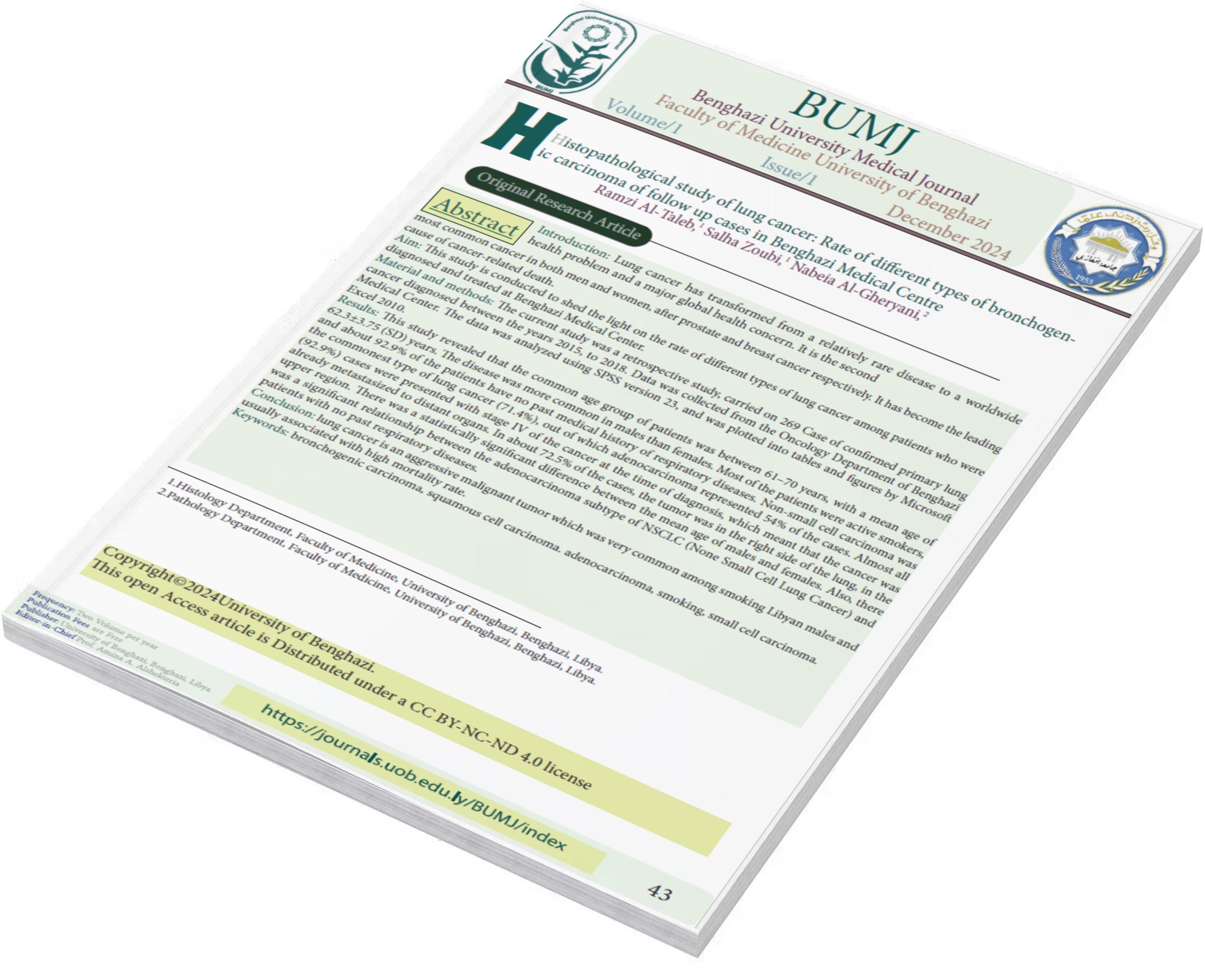Histopathological study of lung cancer: Rate of different types of bronchogenic carcinoma of follow up cases in Benghazi Medical Centre
DOI:
https://doi.org/10.37376/benunivmedj.v1i1.7140Keywords:
bronchogenic carcinoma, squamous cell carcinoma, adenocarcinoma, smoking, small cell carcinomaAbstract
Introduction: Lung cancer has transformed from a relatively rare disease to a worldwide health problem and a major global health concern. It is the second most common cancer in both men and women, after prostate and breast cancer respectively. It has become the leading cause of cancer-related death.
Aim: This study is conducted to shed the light on the rate of different types of lung cancer among patients who were diagnosed and treated at Benghazi Medical Center.
Material and methods: The current study was a retrospective study, carried on 269 Case of confirmed primary lung cancer diagnosed between the years 2015, to 2018. Data was collected from the Oncology Department of Benghazi Medical Center. The data was analyzed using SPSS version 23, and was plotted into tables and figures by Microsoft Excel 2010.
Results: This study revealed that the common age group of patients was between 61–70 years, with a mean age of 62.3±3.75 (SD) years. The disease was more common in males than females. Most of the patients were active smokers, and about 92.9% of the patients have no past medical history of respiratory diseases. Non-small cell carcinoma was the commonest type of lung cancer (71.4%), out of which adenocarcinoma represented 54% of the cases. Almost all (92.9%) cases were presented with stage IV of the cancer at the time of diagnosis, which meant that the cancer was already metastasized to distant organs. In about 72.5% of the cases, the tumor was in the right side of the lung, in the upper region. There was a statistically significant difference between the mean age of males and females. Also, there was a significant relationship between the adenocarcinoma subtype of NSCLC (None Small Cell Lung Cancer) and patients with no past respiratory diseases.
Conclusion: lung cancer is an aggressive malignant tumor which was very common among smoking Libyan males and usually associated with high mortality rate.
References
Cao W, Chen HD, Yu YW, Li N, Chen WQ. Changing profiles of cancer burden worldwide and in China: a secondary analysis of the global cancer statistics 2020. Chin Med J 2021; 134:783–791.
Moreno, A. Treating Very Large Non-Small Cell Lung Cancers: A Survival Analysis Using National Cancer Databases”. Doctor of Medicine. Yale University; School of Medicine (2014). Yale Medicine Thesis Digital Library 1908.
Witschi H. A Short History of Lung Cancer, Toxicological Science 2001; 64 (1) Pages 4–6.
American Cancer Society. Key statistics for lung cancer (reviewed 2023 Jan 12; cited 2023 Mar 1) Available from https://www.cancer.org/cancer/lung cancer/about/key-statistics.html.-
Akhtar S., Abu Bakr M., Dawi S., Huq I. Cancer in Libya--a retrospective study (1981-1985). Afr J Med Med Sci. 1993;22(1):17-24.
Zarmouh A, Almalti A, Alzedam A, Hamad M, El Mughrabi H, Alnajjar L, et al. Cancer incidence in the middle region of Libya: Data from the cancer epidemiology study in Misurata. Cancer Rep (Hoboken). 2022; 5(1): e1448.
El Mistiri M, Pirani M, El Sahli N, El Mangoush M, Attia A, Shembesh R, et al Cancer profile in Eastern Libya: incidence and mortality in the year 2004. Ann Oncol. 2010 ;21(9):1924-1926.
El Mistiri M, Pirani M, El Sahli N, El Mangoush M, Attia A, Shembesh R, et al.Cancer profile in Eastern Libya incidence and mortality in the year 2004.Ann Oncol.2010;21(9):1924-26.
Jazieh A, Al gwaiz G, Errihani H, El ghissassi I, Mula-Hussain L, Bawazir AA et al. Lung Cancer in the Middle East and North Africa Region. J Thorac Oncol. 2019;14(11):1884-1891.
Dela S., Tanoue T., Matthay A. Lung cancer: epidemiology, etiology, and prevention. Clin Chest Med2011 Dec;32(4):605-44.
Kreuzer M, Kreienbrock L, Müller M, Gerken M, Wichmann E. Histologic types of lung carcinoma and age at onset. Cancer. 1999 ;85(9):1958-65.
Tolwin Y, Gillis R, Peled N. Gender and lung cancer-SEER-based analysis. Ann Epidemiol. 2020; 46:14-19.
Mandour I, Hussein M, Essam R, El-Hossainy A. Study of genetic variants in chromosome 5p15.33 regions in non-smoker lung cancer patients. Adv Respir Med. 2020;88(6):485-494.
Thai A, Solomon J, Sequist V, Gainor F, Heist S. Lung cancer. Lancet. 2021 398(10299):535-554.
Ganti K, Klein B, Cotarla I, Seal B, Chou E. Update of incidence, prevalence, survival, and initial treatment in patients with Non–Small Cell Lung Cancer in the US. JAMA Oncol. 2021;7(12):1824–1832.
Jia B, Zheng Q, Qi X, Zhao J, Wu M, An T, Wang Y et al. Survival comparison of right and left side non-small cell lung cancer in stage I-IIIA patients: A Surveillance Epidemiology and End Results (SEER) analysis. Thorac Cancer. 2019 10(3):459-471.
Yang Y, Shi C, Sun H, Yin W, Zhou X, Zhang L, et al. Elderly male smokers with right lung tumors are viable candidates for KRAS mutation screening. Sci Rep. 2016 7; 6:18566.
Ellis, R. What are EGFR mutations in NSCLC? WebMD (online) 2022. Available at: https://www.webmd.com/lung-cancer (Accessed: 25 June 2023).
Bryan S, Masoud H, Weir K, Woods R, Lockwood G, Smith L, et al. Cancer in Canada: Stage at diagnosis. Health Rep. 2018 ;29(12):21-25.
Riihim M, Hemminki A, Fallah M, Thomsen H, Sundquist K, Sundquist J, et al. Metastatic sites and survival in lung cancer. Lung Cancer. 2014;86(1):78-84.
Farach-Carson, C. ‘Sex differences and bone metastases of breast, lung, and prostate cancers: Do bone homing cancers favor feminized bone marrow?’, Frontiers in Oncology,2017; 7; (10)3389.
Mandour I, Hussein M, Essam R, El-Hossainy A. Study of genetic variants in chromosome 5p15.33 regions in non-smoker lung cancer patients. Adv Respir Med. 2020;88(6):485-494.
Corrales L, Rosell R, Cardona F, Martín C, Zatarain L, Arrieta O. Lung cancer in never smokers: The role of different risk factors other than tobacco smoking. Crit Rev Oncol Hematol. 2020 ; 148:102895.
Yoshida K, Takizawa Y, Nishino Y, Takahashi S, Kanemura S, Omori J, et al. Association between Family History of Cancer and Lung Cancer Risk among Japanese Men and Women. Tohoku J Exp Med. 2019 ;247(2):99-110.
Ambrosone B, Rao U, Michalek M, Cummings M, Mettlin J. Lung cancer histologic types and family history of cancer. Analysis of histologic subtypes of 872 patients with primary lung cancer. Cancer. 1993;15;(4):1192-8.
Brenner R, McLaughlin R, Hung J. Previous lung diseases and lung cancer risk: a systematic review and meta-analysis. PLoS One. 2011;6(3): e17479.
Mouronte C, Fernandez A, Ruano A, Ramos C, Tilve A, Rodr P, et al. Influence of the type of emphysema in the relationship between COPD and lung cancer. Int J Chron Obstruct Pulmon Dis. 2018; 13:3563-3570
Myers J, Wallen M. Lung Adenocarcinoma. In: Stat Pearls [Internet]. Treasure Island (FL):Stat Pearls Publishing; 2022; PMID: 30137862.
Brown S, Eraut D, Trask C, Davison G. Age and the treatment of lung cancer. Thorax. 1996; 51(6):564-8.
Kotecha J, Clark A, Burton M, Chan Y, Menzies D, Dernedde U, et al. Evaluating the delay prior to primary care presentation in patients with lung cancer: a cohort study. BJGP Open. 2021; 5(2).BJGPO.2020.0130.
Bjerager M, Palshof T, Dahl R, Vedsted P, Olesen F. Delay in diagnosis of lung cancer in general practice. Br J Gen Pract. 2006;56(532):863-8.
Lee E., Kazerooni E. A. Lung cancer screening. Semin Respir Crit Care Med 2022 ;43(6):839-850.

Downloads
Published
How to Cite
Issue
Section
License
Copyright (c) 2024 Benghazi University Medical Journal

This work is licensed under a Creative Commons Attribution-NonCommercial-NoDerivatives 4.0 International License.
Copyright©2024University of Benghazi.
This open Access article is Distributed under a CC BY-NC-ND 4.0 license








 Copyright
Copyright


